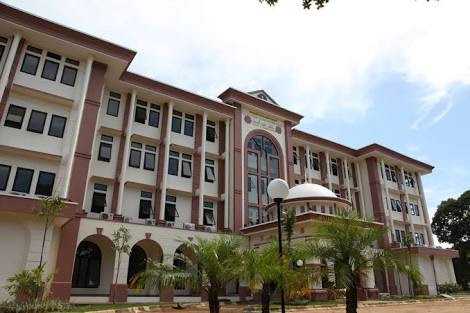SYSTEMATIC LITERATURE REVIEW (SLR) : Teknologi dalam Pembelajaran Matematika selama Satu Dekade Terakhir
SYSTEMATIC LITERATURE REVIEW (SLR) TEKNOLOGI DALAM PEMBELAJARAN MATEMATIKA SELAMA DEKADE TERAKHIR
Abstrak
Penggunaan teknologi dalam pembelajaran Matematika di era digital saat ini sangatlah penting. Namun, pengetahuan tentang teknologi dalam pembelajaran Matematika masih kurang bagi mayoritas staf pengajar. Oleh karena itu, penting untuk melakukan penelitian dasar mengenai teknologi dalam pengajaran Matematika. Penelitian ini merupakan kajian pustaka yang bertujuan untuk mengkaji artikel tentang Teknologi dalam Pembelajaran Matematika yang meliputi aplikasi, perangkat lunak, platform, dan penyedia mata kuliah online yang digunakan dalam pembelajaran Matematika. Artikel yang diulas adalah artikel berbahasa Inggris yang diterbitkan dari 2013 hingga 2022 di database Springer. Proses penentuan artikel yang dianalisis dalam penelitian ini menggunakan prinsip Preferred Reporting Items for Systematic Reviews and Meta-Analyses (PRISMA). Berdasarkan hasil analisis diperoleh 1) sebaran publikasi artikel tertinggi tahun 2022 yaitu 24 artikel; 2) teknologi yang paling banyak digunakan (aplikasi, perangkat lunak, platform, dan penyedia kursus online) adalah GeoGebra dan Video (video animasi, video pembelajaran, dan tutorial video), Game Digital dan Sistem Bimbingan Belajar Cerdas (ITS); 3) artikel terbanyak, yaitu artikel dengan 3 penulis, 23 artikel; 4) bahwa negara-negara dengan peneliti terbanyak yang melakukan penelitian tentang teknologi dalam pengajaran matematika adalah Amerika Serikat dan Inggris dengan persentase masing-masing 35,06% dan 12,99%; dan 5) Penerbit yang paling banyak menerbitkan artikel tentang teknologi dalam pembelajaran Matematika adalah Pengalaman Digital dalam Pendidikan Matematika. Peneliti merekomendasikan untuk melakukan penelitian meta-analisis tentang dampak penggunaan teknologi pada pembelajaran Matematika.
##plugins.generic.usageStats.downloads##
Referensi
Alabdulaziz, M. S. (2021). Covid-19 and the use of digital technology in mathematics education. Education and Information Technologies, 26(6), 7609–7633. https://doi.org/10.1007/s10639-021-10602-3.
Benning, I., Linsell, C., & Ingram, N. (2018). Using technology in mathematics: Professional development for teachers.
Chao, T., Chen, J., Star, J. R., & Dede, C. (2016). Using digital resources for motivation and engagement in learning mathematics: reflections from teachers and students. Digital Experiences in Mathematics Education, 2(3), 253–277. https://doi.org/10.1007/s40751-016-0024-6.
Chinnappan, M., & Thomas, M. (2000). Technology in mathematics learning and teaching. Mathematics Education Research Journal, 12(3), 173–176. https://doi.org/10.1007/BF03217083.
Clark-Wilson, A., Robutti, O., & Thomas, M. (2020). Teaching with digital technology. ZDM - Mathematics Education, 52(7), 1223–1242. https://doi.org/10.1007/s11858-020-01196-0.
Del Olmo-Munoz, J., Gonzalez-Calero, J. A., Diago, P. D., Arnau, D., & Arevalillo-Herraez, M. (2022). Intelligent tutoring systems for word problem-solving in covid-19 days: Could they have been (part of) the solution? ZDM - Mathematics Education, 2020. https://doi.org/10.1007/s11858-022-01396-w.
Drijvers, P., Thurm, D., Vandervieren, E., Klinger, M., Moons, F., Van der Ree, H., Doorman, M. (2021). Distance mathematics teaching in Flanders, Germany, and the Netherlands during covid-19 lockdown. Educational Studies in Mathematics, 108(1–2), 35–64. https://doi.org/10.1007/s10649-021-10094-5.
Fowler, S., Cutting, C., Kennedy, J. P., Leonard, S. N., Gabriel, F., & Jaeschke, W. (2021). Technology-enhanced learning environments and the potential for enhancing spatial reasoning: A mixed methods study. Mathematics Education Research Journal, 887–910. https://doi.org/10.1007/s13394-021-00368-9.
Gamage, S. H. P. W., Ayres, J. R., & Behrend, M. B. (2022). A systematic review of trends in using moodle for teaching and learning. International Journal of STEM Education, 9(1). https://doi.org/10.1186/s40594-021-00323-x.
Hergenhahn, B. R., & Olson, M. H. (2015). Theories of Learning. Jakarta: Kencana.
Hewitt, D. (2016). Designing educational software: The case of grid algebra. Digital Experiences in Mathematics Education, 2(2), 167–198. https://doi.org/10.1007/s40751-016-0018-4.
Irwanto, I. (2021). Research trends in technological pedagogical content knowledge (TPACK): A systematic literature review from 2010 to 2021. European Journal of Educational Research, 10(4), 2045–2054.
Jupri, A., Drijvers, P., & Van den Heuvel-Panhuizen, M. (2015). Improving grade 7 students’ achievement in initial algebra through a technology-based intervention. Digital Experiences in Mathematics Education, 1(1), 28–58. https://doi.org/10.1007/s40751-015-0004-2.
Kurniati, R., & Ramly, R. A. (2022). Development of macromedia flash module in the learning media course faculty of teacher training and education university of pejuang republik Indonesia. MaPan : Jurnal Matematika Dan Pembelajaran, 10(2), 366–384.
Larison, S., Richards, J., & Sherin, M. G. (2022). Tools for supporting teacher noticing about classroom video in online professional development. Journal of Mathematics Teacher Education, 3. https://doi.org/10.1007/s10857-022-09554-3.
Moore-Russo, D., Diletti, J., Strzelec, J., Reeb, C., Schillace, J., Martin, A., … Scanlon, S. (2015). A study of how angry birds has been used in mathematics education. Digital Experiences in Mathematics Education, 1(2–3), 107–132. https://doi.org/10.1007/s40751-015-0008-y.
Nurviani, R., & Abdullah, M. R. (2022). Revisiting PIMRS and curriculum instruction management: evaluation of principalship in Banda Aceh. Indonesian Journal of Curriculum and Educational Technology Studies, 10(1), 9–24. https://doi.org/10.15294/ijcets.v10i1.51149.
Nurwijaya, S. (2019). Development of mathematics learning package with geogebra-assisted scientific approach for the eight graders. Global Science Education Journal, 1(1), 79–87.
Panorkou, N., & Pratt, D. (2016). Using google sketchup to develop students’ experiences of dimension in geometry. Digital Experiences in Mathematics Education, 2(3), 199–227. https://doi.org/10.1007/s40751-016-0021-9.
Roorda, G., Vos, P., Drijvers, P., & Goedhart, M. (2016). Solving rate of change tasks with a graphing calculator: A case study on instrumental genesis. Digital Experiences in Mathematics Education, 2(3), 228–252. https://doi.org/10.1007/s40751-016-0022-8.
Snyder, H. (2019). Literature review as a research methodology: An overview and guidelines. Journal of Business Research, 104(August). https://doi.org/10.1016/j.jbusres.2019.07.039.
Sokolowski, A., Li, Y., & Willson, V. (2015). The effects of using exploratory computerized environments in grades 1 to 8 mathematics: A meta-analysis of research. International Journal of STEM Education, 2(1). https://doi.org/10.1186/s40594-015-0022-z.
Sudarsana, I. K., Nakayanti, A. R., Sapta, A., Haimah, Satria, E., Saddhono, K., Mursalin, M. (2019). Technology application in education and learning process. Journal of Physics: Conference Series, 1363(01), 012061. https://doi.org/10.1088/1742-6596/1363/1/012061.
Tepla, M., Teply, P., & Smejkal, P. (2022). Influence of 3D models and animations on students in natural subjects. International Journal of STEM Education, 9(1). https://doi.org/10.1186/s40594-022-00382-8.
Wang, L. H., Chen, B., Hwang, G. J., Guan, J. Q., & Wang, Y. Q. (2022). Effects of digital game-based STEM education on students’ learning achievement: A meta-analysis. International Journal of STEM Education, 9(1). https://doi.org/10.1186/s40594-022-00344-0.
Xu, W., & Ouyang, F. (2022). The application of AI technologies in STEM education: a systematic review from 2011 to 2021. International Journal of STEM Education, 9(1). https://doi.org/10.1186/s40594-022-00377-5.
##submission.copyrightStatement##
##submission.license.cc.by4.footer##
